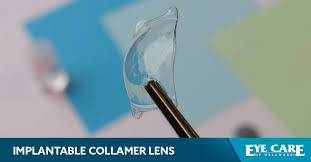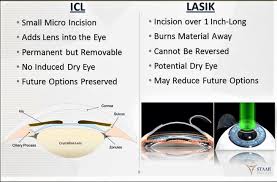Introduction to Collamer
In recent years, advancements in vision correction have introduced numerous innovative solutions to address refractive errors. One such revolutionary material making waves in ophthalmology is Collamer. Known for its exceptional comfort, biocompatibility, and outstanding visual outcomes, Collamer lenses have become a preferred choice for many patients seeking long-term vision correction.
But what exactly is Collamer, and why is it transforming the way we correct vision? This comprehensive article will take you through everything you need to know about Collamer lenses—from their composition to their remarkable benefits and applications.
Definition and Overview
Collamer is a unique, biocompatible material used in ophthalmic lenses, particularly in implantable collamer lenses (ICLs). Collamer combines collagen copolymer and other biocompatible substances, with its name derived from these key components.
Unlike traditional lens materials, Collamer offers exceptional optical clarity, UV protection, and comfort, making it ideal for use in intraocular lenses (IOLs) and phakic intraocular lenses (PIOLs). Developed by STAAR Surgical, Collamer has rapidly gained recognition for its durability and compatibility with the eye’s natural tissue.

Why It’s Important in Ophthalmology
Collamer’s rise in the field of ophthalmology is not just a trend but a response to a growing need for reliable and sustainable vision correction. Traditional lenses often fall short when it comes to long-term comfort and minimizing side effects like dry eyes. Collamer’s unique properties and remarkable performance make it a game-changer, offering patients a safe, long-lasting solution to refractive errors.
Composition and Properties of Collamer
What Is Collamer Made Of?
Collamer is primarily composed of collagen copolymer, a blend of purified collagen and a hydrophilic polymer. This combination results in a flexible, soft lens material that closely resembles the natural tissue of the eye, minimizing irritation and the risk of rejection.
Unique Features That Make It Special
- Biocompatibility: Minimizes the risk of adverse reactions.
- Blocks Harmful UV Rays: Safeguards your eyes against the damaging effects of ultraviolet radiation.
- Enhanced Clarity: Offers superior visual quality with reduced glare and halos.
- Hydrophilic Nature: Reduces dryness and maintains comfort.
How Collamer Lenses Work
The Science Behind Vision Correction
Collamer lenses work by correcting the refractive error through the precise placement of the lens within the eye. Unlike traditional LASIK surgery that reshapes the cornea, Collamer lenses are implanted behind the iris, offering a reversible and adjustable option for vision correction.
Comparison with Other Lens Materials
| Feature | Collamer | Silicone | PMMA |
|---|---|---|---|
| Biocompatibility | High | Moderate | Low |
| Comfort | Exceptional | Moderate | Poor |
| UV Protection | Yes | No | No |
| Clarity | Excellent | Good | Moderate |
| Dry Eye Reduction | Significant | Minimal | None |
Applications of Collamer in Eye Surgery
Implantable Collamer Lenses (ICL)
ICLs are a popular choice for patients with high myopia or astigmatism. These lenses are implanted behind the iris and in front of the natural lens, correcting vision without the need for corneal modification.
Use in Phakic Intraocular Lenses (PIOLs)
PIOLs are designed for younger patients who are not ideal candidates for LASIK. These lenses provide sharp and clear vision while preserving the eye’s natural lens.
Collamer vs. Traditional Contact Lenses
Comfort and Biocompatibility
Collamer lenses feel incredibly natural and reduce the risk of dry eye syndrome, making them superior to many contact lenses.
Longevity and Maintenance
Unlike daily or monthly contact lenses, Collamer lenses are long-lasting and require minimal maintenance, offering a cost-effective solution in the long run.
Benefits of Collamer Lenses
UV Protection
Collamer lenses naturally block UV radiation, helping to protect the retina from potential damage caused by prolonged sun exposure.
Enhanced Night Vision
Patients often report clearer vision at night, with fewer instances of glare and halos, a common problem with other types of corrective lenses.
Reduced Dry Eye Symptoms
The hydrophilic nature of Collamer lenses ensures that the eyes remain moist, significantly reducing the risk of dry eye syndrome.
Who Is a Candidate for Collamer Lenses?
Eligibility Criteria
- Individuals aged 21 to 45
- Stable vision for at least one year
- No history of ocular diseases or infections
- Not suitable for patients with thin corneas or autoimmune conditions
Procedure for Implanting Collamer Lenses
Pre-Surgery Preparations
- Detailed eye examination
- Discussion of potential risks
- Temporary contact lens removal
Step-by-Step Surgical Process
- Numbing Drops: To ensure comfort during the procedure.
- Small Incision: Made at the cornea’s edge.
- Lens Insertion: The Collamer lens is inserted and positioned.
- Recovery: Typically quick, with minimal discomfort.
Recovery and Post-Operative Care
- Avoid rubbing eyes and heavy activities.
- Follow the prescribed eye drop regimen.
- Regular follow-up visits to monitor healing.
Risks and Complications of Collamer Lenses
Possible side effects include mild inflammation, glare, and halos. However, these are typically temporary and manageable with proper care.
Collamer Lenses vs. LASIK Surgery
Key Differences
- Reversibility: Collamer lenses can be removed, while LASIK is permanent.
- Corneal Preservation: LASIK alters the cornea, but Collamer lenses do not.
- High Myopia and Astigmatism: Collamer lenses are more effective.

Collamer Lenses for High Myopia and Astigmatism
Clinical studies have shown remarkable results for patients with severe refractive errors, offering clear and stable vision where LASIK may fall short.
The Cost of Collamer Lenses
The cost of Collamer lens implantation ranges from $3,500 to $5,000 per eye, depending on factors such as the surgeon’s expertise and the lens model.
Future of Collamer Technology
Research is ongoing to develop even thinner and more flexible collamer lenses, enhancing their effectiveness and comfort. The future of vision correction looks promising with continued advancements in this field.
Conclusion
Collamer lenses represent the next generation of vision correction technology, offering superior comfort, safety, and effectiveness. Whether you suffer from high myopia, astigmatism, or want a reversible solution to vision problems, Collamer lenses may be your ideal choice.
Invest in your vision and discover the transformative power of Collamer lenses—a revolutionary approach to seeing the world clearly and comfortably.
Author Details:
Dr. Sushruth Appajigowda holds a prominent position as a cornea, cataract, glaucoma, and LASIK surgeon in Bangalore. He serves as the chief cataract and refractive surgeon at Vijaya Nethralaya Eye Hospital, Nagarbhavi, Bangalore. Renowned as one of the finest LASIK surgeons nationwide, he brings with him over 12 years of experience across multiple LASIK platforms, including ZEISS, ALCON, SCHWIND, AMO, and Bausch and Lomb. Having successfully conducted over 5000 LASIK procedures, Dr. Sushruth holds the title of a Certified Refractive Surgeon and a Fellow of the All India Collegium of Ophthalmology. Furthermore, he stands as a distinguished speaker at various national and international forums, using his expertise to guide you in selecting the most suitable procedure based on your health requirements.

http://vijayanethralaya.com/link-in-bio/
FAQs
Can I see them immediately after the surgery?
Vision improves significantly within 24–48 hours after implantation.
Are Collamer lenses permanent?
No, they can be removed or replaced if necessary.
Can Collamer lenses cause dry eyes?
No, they do not interfere with tear production like LASIK does.
How long does the procedure take?
The implantation process takes about 15–30 minutes per eye.
Is the surgery painful?
No, the procedure is performed under local anesthesia, making it painless.












